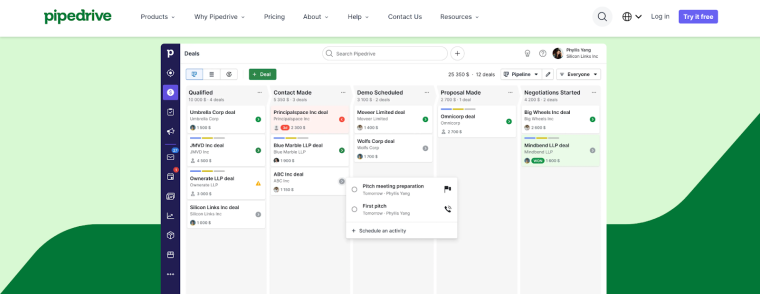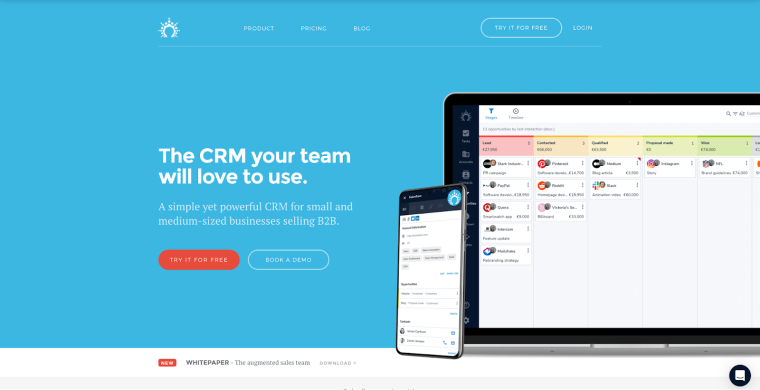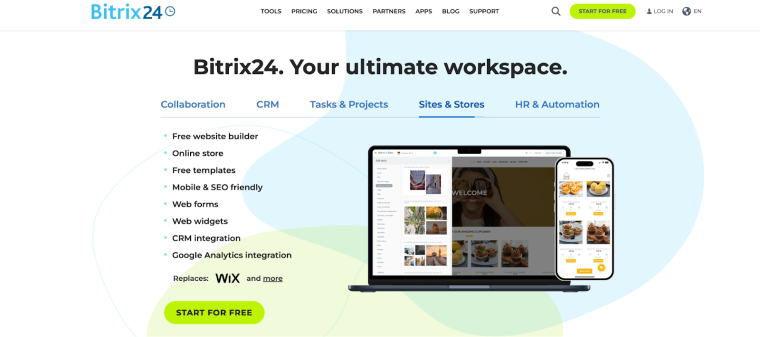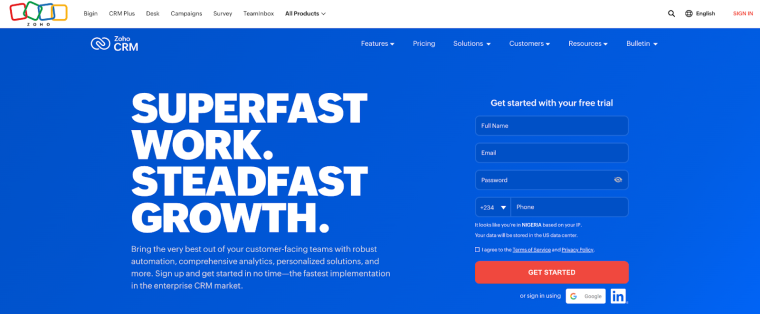Extensive sales tracking offers more than the ability to monitor your monthly or quarterly sales figures. It provides valuable insights that can facilitate sales forecasts and expected net revenue. Sales tracking can also help you betterf understand which of your marketing strategies are effective and which are falling short.
This review explains how sales tracking software works and the sales metrics you need to be tracking to stay ahead of the game.
What Is Sales Tracking?
Before diving into the tech solutions to track your business’ sales, it is important to know exactly what sales tracking is.
In simple terms, sales tracking is the way to quickly and accurately keep track of your sales activities. A deeper definition is that it involves how businesses watch, log, and study the sales efforts of their in-person and remote teams during the whole selling process.
Modern-day businesses now rely on sales tracking software and tech solutions. According to LinkedIn’s Global State of Sales report, about 43% of sales teams acknowledged using intelligence tools for their sales tracking and pipeline, which depicts a 54% increase from two years prior.
These tools assist businesses in gathering the data required for precise sales records and forecasts. They also enable them to track net revenue and see how their marketing strategies affect sales performance. A Databox survey found that around 43.14% of companies use software to oversee their sales pipeline.
These sales tracking software go one step further. They properly interpret and provide detailed insights into the effectiveness of sales strategies. Additionally, they pinpoint areas that require improvement to achieve the desired outcome.
These tools give you a broader perspective on your business performance. Visibly seeing your entire selling process can help your sales team make better decisions and further streamline their ability to close deals.
Why Is Sales Tracking Important for Businesses?
Sales tracking software offers numerous functionalities that can serve as microscopes, allowing you to zoom in on what is working and what isn’t. Below, we explore some of the most prominent reasons why sales tracking is important:
-
Performance Evaluation
Regular performance evaluation is absolutely vital for a successful business. This allows the business to focus on the most successful strategies and optimize ineffective ones.
Sales tracking software enables performance evaluation for teams and the business. You can see in real-time the output your sales team is generating and gauge where the company is heading. For instance, if you notice that your business is suffering from a high customer churn rate, you can direct salespeople to focus on building more customer loyalty to help solve the problem.
-
Goal Setting and Forecasting
By drawing insights from sales tracking software, you can better set short and long-term goals on your sales projections and craft successful strategies to meet them. From this, you can review prior data gathered and spot trends, making it easier to make precise sales forecasting.
According to a Salesforce report, underperforming sales teams are 1.7 times more likely to forecast on intuition. This could harm the business as an instinctive feeling is not based on data and may lead your business in the wrong direction. Meanwhile, sales tracking software provides the raw data to make cogent, evidence-driven decisions.
-
Financial Management
Sales tracking software is an information hub. This means you have access to your overall business health, especially your sales pipeline and revenue streams. Moreso, you can test and compare the costs of sales and marketing strategies.
With these details at your fingertip, you are better informed on your business’s financial health and can make smart decisions in line with it. You can then leverage this information and either improve your service to a particular market segment or launch into a new market entirely.
-
Gives Your Sales Team Structure
Sales tracking software creates a structure for your team and processes. Besides providing a working template, sales tracking software can help manage sales records and maintain the structure. Your sales process is more streamlined as every step is duly adjusted to reflect changes.
-
Identify Bottlenecks
Sales tracking software can help you identify bottlenecks in your processes and take corrective measures to address them. Whether it’s poor lead generation, extended sales cycle, or poor follow-up, you can identify these details in real time and make the needed adjustments to improve your team’s performance. According to a Sales Management Association report, about 30% of organizations have the proper management systems for performance reporting. This points to a chasm in how much businesses need sales tracking software to identify challenges beforehand.
-
Enhances Accountability
Sales tracking software encourages accountability amongst your sales force. With everyone able to track their individual and collective performance, they can better see where they are doing great and where they aren’t. This creates an accountable mindset and inspires them to put in more effort to reach the predetermined targets.
What Sales Metrics Should be Tracked?
Tracking sales metrics is crucial to the growth of an organization. They allow business owners to gain insights into sales teams’ operations and help leaders make data-based decisions about sales operations. This section highlights the major sales metrics that drive sustainable growth:
1. Revenue Generation Metrics
Central to the efforts of every sales team is the generation of revenue. Monitoring metrics related to revenue offers a clear understanding of the team’s performance in income generation. Important metrics falling into this category include:
Total Revenue
The total revenue metric portrays the overall income derived from sales and is a fundamental value for assessing the success of any sales campaign. It can also evaluate how certain products from different categories or locations perform. For example, total revenue generated from Manchester vs. total revenue generated from Leeds.
Average Revenue Per Account (ARPA)/Product/Customer
ARPA is a business’s revenue per account or customer at any given period. This indicator can provide insights into the business’ customer acquisition cost and which customer groups or regions generate more revenue than others. For instance, if the company’s ARPA for a certain segment rises, it generally means that your sales strategy for that particular segment is working well and you should try extrapolating it to other groups. In contrast, if the ARPA slumps, the sales team might want to consider innovating with new strategies to increase ARPA. This could include adding or cross-selling successful products from other segments.
2. Conversion Metrics
The primary objective of any sales team, along with generating as much revenue as possible, is to convert leads into paying customers. We have listed some important indicators for salespeople to monitor below:
Number of Sales or Leads
The number of sales or leads that a salesperson or sales team brings in on a regular basis is the simplest vital measure of performance in sales tracking. It isn’t perfect and doesn’t always totally reflect the ability of the salesperson or their strategy but it is always important to keep an eye on. Always try to understand every major swing that arises in the number of sales or leads flowing in. If it suddenly spikes, try to figure out why so that you can continue to replicate that success. If it crashes, act as fast as possible to remedy the issue so that it doesn’t continue or get worse.
Average Lead Response Time
The average lead response time refers to how fast a company responds to a sales lead. Swift company responses increase the chances of converting a lead into a customer.
Monitoring this data aids in diminishing response durations and augmenting lead conversion rates. As stated in a whitepaper co-authored by Google and the Corporate Executive Board, approximately 35-50% of sales are awarded to the team that responds the quickest.
Win Rate
The win rate measures sales effectiveness. The sales win rate pertains to the number of opportunities that turn into sales. It is assessable both on a team-wide and individual basis, delivering valuable insights into competence and efficiency.
Churn Rate
The churn rate measures the percentage of customers lost over a specific period. Understanding churn helps teams address retention issues and refine their sales strategies.
3. Metrics for Sales Activities
The actions carried out by sales representatives hold substantial influence over the overall team’s performance. Simply, you need to know if your sales team is putting in the work. Monitoring these metrics yields insights into the efficacy of individual sales endeavors and pinpoints areas necessitating enhancement. Key sales activity metrics consist of the following:
Number of Calls/Emails Per Day
Monitoring the quantity of outreach attempts made each day provides a gauge of the team’s proactive engagement with leads and prospects. The more the better unless it starts to affect other metrics negatively. Keep an eye on conversion rates as well as the sheer number of calls to help gauge the effectiveness of a sales person or team.
Follow-up Frequency
Consistent follow-ups often prove pivotal for finalizing deals. Tracking follow-up frequency ensures leads aren’t left unattended for excessive durations, leading to more sales.
Duration of Sales Cycle
Getting a grasp on the average time required to transition a lead from initial contact to closure enables teams to refine their processes and identify potential obstacles. The lower the time the more efficient the sales team is.
4. Customer-Centric Metrics
Satisfied customers are the bedrock of sustained business growth. Metrics within this realm provide insights into customer contentment and the likelihood of repeat business:
Customer Satisfaction (CSAT) Score
Regular assessment of customer satisfaction through surveys or feedback mechanisms offers an understanding of how well the sales process aligns with customer expectations. Tweak your sales process using intel from these feedback mechanisms to keep customers as happy as possible, reducing churn and increasing customer loyalty.
Net Promoter Score (NPS)
Net promoter score or NPS evaluates the likelihood of customers recommending your product or service to others. It empowers you to gain deeper insights into your customers’ interactions, allowing you to implement measures for enhancing customer contentment. NPS is an indicator of overall customer loyalty and brand perception.
Customer Lifetime Value (CLV)
Customer lifetime value is another important customer-focused metric to track. The CLV estimates the cumulative value a customer brings to the business over their entire engagement. This helps make well-informed choices concerning methods for attracting and maintaining customers.
Top Strategies to Turbocharge Revenue With Sales Tracking Insights
Whether a new startup or a well-established corporation, understanding your sales metrics is important in developing sustainable growth. Let’s delve into some of the top sales tracking strategies.
Using Pioneering Technologies to Enhance Efficiency
Due to continuous advancements in technology, various aspects of the sales process are being automated, leading to increased efficiency and convenience for your sales staff. The insights gained with sales tracking tools can be multiplied by using cutting-edge technology to make the most out of your insights.
The current market boasts an array of sales empowerment tools, with cloud-based CRM (customer relationship management) systems standing out as a notable example. A proficient CRM facilitates smoother collaboration and simplifies the task of monitoring calls and managing client interactions.
For example, a 2022 LinkedIn States of Sales report noted that 80% of sales professionals in the United States and Canada who achieved or exceeded 150% of their targets use sales technology at least once weekly.
Moreover, devices like tablets and headsets enable your sales team to seamlessly juggle multiple tasks. This ensures meticulous documentation of client meetings and calls without diverting your salespeople’s attention from their clients.
The pivotal aspect of integrating technology into your sales team’s efforts lies in ensuring its seamless compatibility with the existing tools and systems your team has already established. This, in turn, results in increased productivity and growth.
Set Specific Goals for Easy Monitoring
Setting specific, clear goals is absolutely fundamental for all kinds of businesses. It’s crucial to delineate objectives distinctly, as ambiguous goals lack the capacity for meaningful progress tracking.
It’s generally a good idea to set multiple goals across various timeframes such as quarterly, monthly, or annually. A Forbes report reveals that businesses that set performance objectives quarterly achieve a 31% higher yield from their performance evaluation systems than those adhering to an annual approach.
When you establish a specific objective, you and your employees gain a clear understanding of your destination and the requisite steps to reach it. This stance is one of the most potent sales strategies for bolstering overall sales.
For instance, a specific goal could be increasing revenue by 60% by the end of 2024. This is specific and clearly defined as a quantifiable and measurable target. Such well-defined objectives impart a sense of purpose to your team and aid in maintaining unwavering focus.
Provide Value
Ultimately, the core of your endeavor revolves around offering value to others in exchange for business income. If potential buyers are unaware of the value proposition or it just doesn’t matter to them, their inclination to purchase diminishes.
Sales tracking enables you and your team to market your product or service to optimize its value proposition through trial and error. Making the product as valuable as possible to the customer ensures greater conversion rates and more sales. For example, if you have found that using info from surveys, previous calls, or other sources in sales calls leads to more sales you can focus on personalizing each and every call that goes out.
Interestingly, an Accenture survey discovered that about 91% of customers are more likely to transact with companies that deliver personalized experiences.
Cold-Calling Optimization
Cold-calling is an inevitable aspect of most sales campaigns. The approach involves swiftly reaching out to potential customers through phone calls or personalized emails. Some think that cold calls are becoming so ineffective that they aren’t worth pursuing but these claims are often exaggerated.
According to SmallBiz Genius, 82% of buyers at least scheduled meetings with salespeople after contact began through a cold call.
Just like any other sales tactic, cold calls need to be optimized as much as possible to get the best results. Make sure to collect as much useful data from cold calls as possible so that you can use it to optimize future cold-calling endeavors. Try A/B testing where you test various different strategies against each other to see which one is the most effective. Put the results together from multiple A/B tests to start to perfect your cold-calling strategy.
Maximizing Customer Retention
The misconception that a sales strategy becomes unnecessary after closing a deal is wholly inaccurate. In fact, account management constitutes a pivotal aspect of the sales journey. It fosters a base of loyal and content customers while capitalizing on possibilities for cross-selling and upselling.
Track the factors that keep customers loyal to your brand and what turns them away. Optimize your customer retention strategy by focusing on implementing tactics that drive loyalty and retention and avoiding those that increase churn or lower customer retention. Always research new strategies to test out as a simple test of a new tactic could entirely change your company’s ability to retain customers.
For example, according to Aberdeen’s research, companies implementing a proficient Voice of the Customer (VoC) initiative can witness a remarkable 55% enhancement in customer retention.
Best Sales Tracking Software
Sales tracking software is vital to optimize a company’s leads and improve competitiveness and sustainability.
However, professionals must pick the best software to meet their unique needs. This section details some of the best sales tracking tools available today.
Salesforce CRM – AI-Powered CRM for Marketing Automation and Sales Analytics
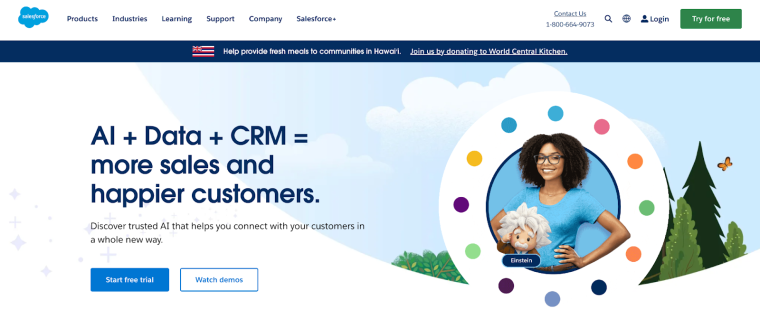
Salesforce is a revered sales tracking CRM software that enables organizations’ teams to track sales growth and leads generation.
What sets Salesforce apart from other CRMs is its stellar AI integrations which enable smooth automation and a range of customization options and scalability, which appeals more to larger businesses.
One of the major perks of the sales tracking software is its offering of many third-party integration options, which makes it an excellent choice for businesses needing to piece different solutions.
Professionals and sales team leads can easily utilize over 3,000 add-ons or other platforms to integrate with Salesflare. This help processes sales and customer-related activities.
The platform also provides comprehensive learning resources to get users of diverse technical backgrounds started easily.
Salesforce offers four pricing options to business owners, with the lowest starting at $25 monthly.
While these pricing models are competitive, this CRM software is not always easy to set up. It may be unsuitable for small businesses that don’t already have a strong understanding of sales tracking and CRM software due to its advanced sales analytics and market automation.
Pipedrive – Best Tool for Sales Optimization and Leads Management
Another stellar sales tracking CRM software that stands out is Pipedrive. This software offers a myriad of helpful features, including a visual pipeline management system that provides real-time visibility into the status of all deals, email tracking, and lead scoring.
The CRM software is suitable for small and medium enterprises (SMEs) and startups seeking to manage and optimize sales leads without facing a steep learning curve.
Pipedrive integrates a simple-layout interface, making it a great choice for businesses seeking an intuitive CRM platform for sales optimization.
Within this simple interface, users can access features like an easy-to-use customizable dashboard to track deals, sales activities, team goals, and overall revenue forecasts.
While these are great, Pipedrive also supports industry-leading features that make its platform stand out from other sales tracking tools, notably its AI-powered Sales Mentor.
The AI sales mentor is built to offer users personalized tips to improve sales performance and forecast revenue.
Pipedrive’s pricing starts at $14 monthly. The software also offers a 14-day free trial, giving you enough time to determine whether it’s the best sales tracking software for your business.
While Pipedrive is customizable, it may be too restrictive for businesses seeking unique or personalized workflows or processes.
Salesflare – Best for Sales Forecasting and Scalability
Salesflare CRM is a state-of-the-art sales tracking software tailored for small businesses known for its sales reports, forecasting, and workflow automation.
Like Pipedrive, Salesflare is quite user-friendly. The CRM features visual drag-and-drop pipelines, customizable stages, custom fields, Gmail, Office Suite, and 3,000+ software tools.
This platform can be customized to prompt small teams to follow up with their customer base and identify areas for improvement. It also offers intuitive dashboards to enhance sales revenues.
Some of the features that set Salesflare apart include web tracking, automated email sequences, email sync, and an extensive scalability ecosystem.
The platform’s lowest pricing is $20 monthly and it offers a 14-day free trial before subscribing as well.
However, there are areas for improvement, such as its limited customizations and workflow, which could make Salesflare unsuitable for businesses seeking steep flexibility and data importation capabilities.
Bitrix24 – Premium CRM for Collaboration, Communication Workflow, and Project Management
Bitrix24 is a sales-tracking software that provides a rich list of collaborations and communication workflows geared towards sales tracking for small and large companies. It’s also one of the best client management software.
The software features a user-friendly interface and bright layouts to facilitate smooth navigation and intuitive integrations like shared calendars and group chats to keep teams focused.
Sales teams can generate leads, automate sales processes, email communications, and sales metrics like rep activities and total revenue.
Bitrix24 is also appealing and trusted by thousands of users for its project management feature.
Salespeople can use this feature to set time-based sales objectives and create Gantt charts as well as Kanban boards without needing a project manager.
Bitrix24 pricing starts at $43 monthly, higher than many of the other platforms on this list but it also offers a free account that just has limited features.
The platform has a few downsides including its high learning curve and its imperfect user interface but it could be a great option for large companies (likely with one of its higher priced accounts) and fledgling startups (for its free account) all the same.
Zoho CRM – Advanced Analytics to Manage Sales Cycle and Customize Target Metrics
Rounding up our list of the best sales tracking software is Zoho CRM. The innovative sales tool comes with intrinsic-driven features designed to track, analyze, and forecast sales performances through metrics.
It caters to communication, fintech, e-commerce, and startup business needs.
For professionals and sales teams looking to get started, the platform offers an intuitive user experience. Zoho CRM features a bright and simple-layout interface with bold prints and various customizable dashboards.
The platform also integrates stellar sales tracking features like AI-powered sales forecasting, sales pipeline management, and automated workflows.
Unlike most top CRM software platforms, Zoho has a robust mobile sales tracking app that enables sales reps to access their sales data and track activities.
Zoho CRM’s pricing starts at $14 monthly, with a 30 to 45-day money-back guarantee. Users can also opt for its limitless free plan though they won’t have access to most of the software’s best features.
Unfortunately, Zoho’s AI automation is locked behind higher-priced plans and it offers a limited number of customer fields.
How to Implement a Thorough Sales Tracking System
In order to develop a thorough sales plan, you will discover the following activities beneficial for the process:
-
Set Your Goals
Before you implement any sales tracking software, setting your performance goals is important. They motivate teams and give employees a task to focus on and perfect.
Businesses can set goals to increase deal sizes, customer lifetime value, or cold calls. By knowing your goals, you can tailor the system to suit your specific requirements and preferences. This will ensure its effectiveness in solving the challenges your business faces.
Take a few hours and write down all of the metrics you want to focus on and estimate goals for each and every single one of them.
Use the data you collect through sales tracking to regularly improve your goals, making them as high as possible while keeping them achievable.
-
Implement Sales Metrics
Identify key performance indicators (KPIs) that align with your goals. These metrics could encompass conversion rates, average deal size, sales cycle length, and customer acquisition cost. Monitor these metrics over time to spot trends and patterns.
According to a Databox survey, 50% of the participants indicated that they monitor between 6 to 10 metrics related to sales performance.
Regularly assessing KPIs empowers you to make data-driven decisions and refine your sales strategies accordingly.
-
Choose the Right Software
Selecting the appropriate sales tracking software forms the foundation of an effective system. According to a survey conducted by Capterra, 47% of companies utilizing CRM systems experience improved customer retention and satisfaction.
Before choosing, consider your budget, specific needs, ease of use, and capabilities. For instance, a robust CRM system like any of the choices listed above can provide all of the features you need.
-
Gather and Integrate Data
Your sales tracking system should consolidate data from various sources to derive valuable insights. This includes gathering information from your website, social media platforms, point-of-sale systems, and other relevant touchpoints.
Make sure you are gathering all of the information you need to fairly gauge your company’s progress in the goals you set in the first step.
According to McKinsey Global Institute, data-driven organizations have higher customer attraction, retention, and profitability rates. Furthermore, by integrating sales tracking software with existing tech solutions, such as your accounting system, you can generate a comprehensive view of the company’s overall well-being and, more importantly, how to improve it.
-
Customize to Business Goals
Off-the-shelf solutions might not perfectly align with your business processes. Luckily, sales tracking tools can be customized to match your workflow. You can adjust data fields, sales stages, and reporting dashboards to fit your needs. This customization enhances user adoption and prevents unnecessary friction in the sales process.
-
Train Your Team
Even the most advanced system is only as effective as its users. Therefore, it is necessary to provide thorough training to your sales team. This enables them to fully comprehend accurate data input and report interpretation, as well as leverage the system’s features to their advantage.
Make sure that your managers know how to use your sales tracking software so that they can track the success of their team and team members with ease and easily make changes to improve their output.
As noted by Zippia, offering extensive training programs can boost a company’s profit margin by 24%. Regular training sessions and ongoing support can keep the team engaged and adept at using the system.
-
Automate Procedures
One of the major benefits of a sales tracking system is its capacity to automate repetitive tasks. You can easily save hundreds of hours of your employees’ time by automating email follow-ups, appointment scheduling, and other routine activities.
Within 12 months, 76% of founders who implemented marketing automation saw a positive ROI, according to Marketo. Automation saves time for your sales team and ensures consistent communication with leads and clients.
-
Ensure Data Security and Privacy
Given that your sales tracking system handles sensitive customer and business data, prioritizing security is paramount. A study by Centrify found that 65% of people who experienced a data breach reported a decline in their trust in the affected company.
Implement robust data encryption, user authentication, and access controls to protect information. To maintain customer trust, adhere to relevant data protection regulations, such as GDPR or CCPA.
-
Pursue Continuous Improvement
A sales tracking system isn’t a one-time use tool. It is a dynamic tool that should be used continuously to adapt to evolving business dynamics.
Regularly evaluate and enhance your system to incorporate new features, emerging technologies, and input from your sales team. This approach guarantees that your system remains pertinent and efficient in the long term.
-
Analyze and Fine-Tune
As time passes, it is necessary to harness the extensive data collected by your sales tracking system to conduct thorough analyses.
Identify strengths and weaknesses in your sales process, pinpoint areas for improvement, and capitalize on opportunities. Insights derived from data empower you to fine-tune your strategies and ultimately make decisions that would create growth.
Is Comprehensive Sales Tracking Worth It for My Business?
Ready to elevate your business to new heights? Comprehensive sales tracking is likely a great option to improve sales in a matter of a few weeks. This software and a bit of extra effort will allow you to better organize leads, track sales rep activities, predict future revenues, and optimize important sales metrics.
According to Zippia CRM statistics, 47% of CRM users reported benefits in customer satisfaction, which leads to customer retention.
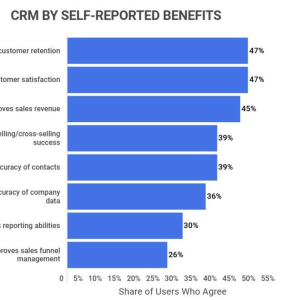
The study point also revealed that 45% of users cited improvements in sales revenue, while 39% said it brought upselling and cross-selling success.
This study showcases the importance of sales tracking CRM towards a continuous boost in sales revenue, customer retention, and sustainability in the ever-evolving market.
A 2021 Statista survey in France cited data-driven insights showing how CRM system growth permeated various industries and business types.
These include Information and Communication, Transport and Storage, Retail Commerce, and Construction, averaging 32% of a hundred enterprises using CRM.
Regardless of their industry, businesses with sales teams should prioritize the integration of sales tracking CRM software. This will significantly optimize their lead conversion and improve sales revenue exponentially.
